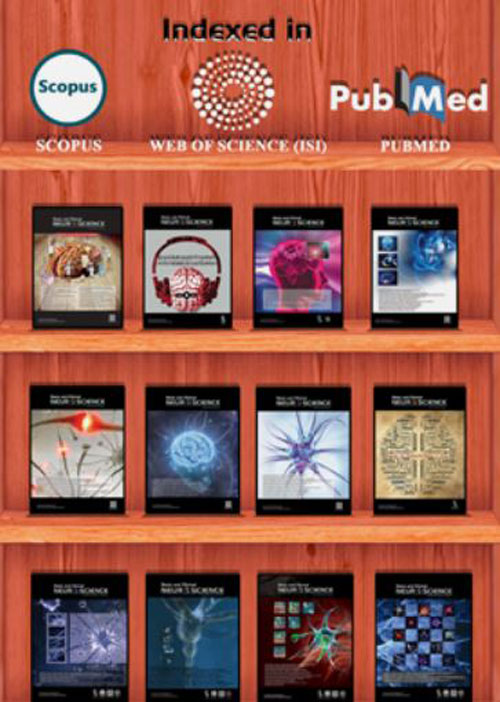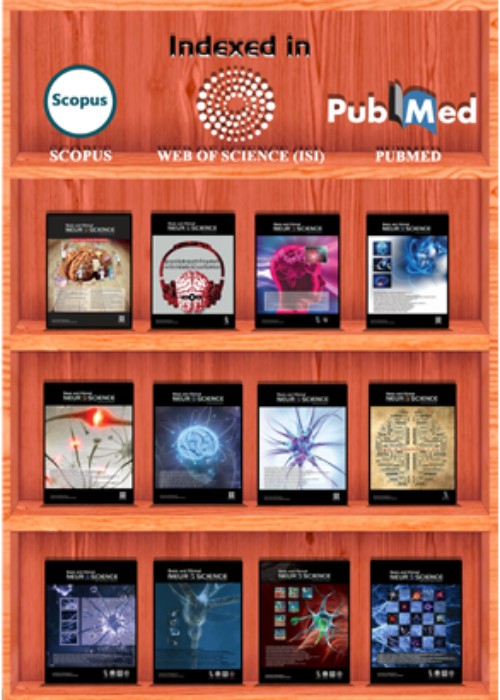فهرست مطالب

Basic and Clinical Neuroscience
Volume:10 Issue: 2, Mar-Apr 2019
- تاریخ انتشار: 1397/12/10
- تعداد عناوین: 8
-
-
Pages 99-107IntroductionThe World Health Organization estimates that about 25 million pregnant mothers are currently at risk for malaria, and that malaria accounts for over 10,000 maternal and 200,000 neonatal deaths per year. The current hypothesis of early life programming supports the premise that many developmental delay and disorders may have their origin In-utero. Therefore, the current study aimed at evaluating the possible impact of experimental malaria exposure In-utero on neurobehavioral profile in mice offspring.MethodsPregnant mice were intraperitoneally infected on gestational day 13 with 1.02×105 infected red blood cells. Pregnant mice (both infected and uninfected) were allowed to deliver and the offspring were monitored up to postnatal day 42 when anxiety-like, Obsessive-Compulsive Disorder (OCD), and locomotor activity were evaluated using elevated plus maze, marble burying, and Open Field Test, respectively.ResultsThe current study showed that maternal infection with Plasmodium berghei resulted in an interesting behavior in offspring characterized by increased anxiety-like and OCD behaviors. Locomotor activity was however not affected.ConclusionIt may be concluded that In-utero exposure to experimental malaria in mice causes behavioral changes.Keywords: Plasmodium berghei, Malaria, In-Utero, Anxiety, Obsessive-Compulsive Disorder
-
Pages 109-117IntroductionDonepezil (DON), an Acetylcholinesterase Inhibitor (AChEI), is widely used in the treatment of Alzheimer’s Disease (AD). The current study aimed at evaluating the effect of donepezil hydrochloride on pyramidal neuron response in CA1 region of a rat model of AD.MethodsIn the current experimental study, adult male Wistar rats were randomly divided into four groups: Nucleus Basalis Magnocellularis (NBM) lesion (the lesions were induced by an electrical method of 0.5 m A, for 3 s in NBM) and three donepezil groups (lesions plus 5, 10, and 15 mg/kg donepezil intraperitoneal injection). Neuronal spontaneous activity to injection of the donepezil and saline were recorded in CA1 region of hippocampal.ResultsThe obtained results showed that IntraPeritoneal (IP) injection of donepezil (10 and 15 mg/kg) increased neuronal spontaneous activity in the rat model of AD.ConclusionThe current study results suggested that acute IP injection of donepezil increased neuronal response in CA1 region of hippocampal in a rat model of AD.Keywords: Alzheimer’s Disease, Electrophysiology, Donepezil, Rats
-
Pages 119-135IntroductionThe long-term adverse effects of transient thyroid function abnormalities at birth on intellectual development are proven. The effect of exercise increases in the presence of sex hormones. The current study aimed at investigating the possibility that a combination of sex hormones and exercise has synergistic effects on neural plasticity in Transient Congenital Hypothyroidism (TCH) rats.MethodsTo induce hypothyroidism in the mothers, Propylthiouracil (PTU) was added to drinking water (100 mg/L) on the 6th day of gestation and continued until the 21st Postnatal Day. From Postnatal Day (PND) 28 to 47, the female and male pups received 17β-estradiol and testosterone, respectively. The mild treadmill exercise began 30 minutes after the sex hormones or vehicle administration. On PND 48, electrophysiological experiments were performed on brain slices.ResultsIncrease of Long-Term Potentiation (LTP) was observed in sedentary-non-hormone female rats of TCH group, compared with that of the control. The exercise enhanced LTP in control rats, but the hormones showed no significant effect. The effect of exercise and sex hormone was not significant in the TCH group. The combination of exercise and testosterone enhanced LTP in TCH male rats, while the combination of exercise and estradiol or each of them individually did not produce such an effect on LTP in TCH female rats.ConclusionThe study findings showed an increase in excitatory transmission despite the returning of thyroid hormone levels to normal range in TCH female rats. Also a combination treatment including exercise and testosterone enhanced LTP in male rats of TCH group, which was a gender-specific event.Keywords: Exercise, Hypothyroid, Sex hormones, Long-Term Potentiation
-
Pages 137-146IntroductionMany studies show that words learned early in life are read more easily than the ones learned later and are less vulnerable to brain damage.Methodsthe first part of the current study, 25 primary school students in the 5th grade read the word groups learned initially during a previous grade. The words used in the experiments were 327 Farsi monosyllable words matched on the other factors involved in Farsi word naming.ResultsThe analysis of covariance (the consistency and frequency as covariates) showed that words learned in earlier grades were read more easily than the ones learned later, showing the known effect of the Age of Acquisition (AoA). In the second part of the study, it was tried to simulate AoA in word naming by a neural network model developed earlier based on connectionist approach. While previous studies used random patterns, in the current study words from primary school books were used. Likewise, words learned early by the model were read better than words learned later. However, there was a failure in replicating previous simulation of AoA in English reading by an algorithm called Quick prop for Farsi. In addition, the model was lesioned by removing some hidden units to see its effect on word reading. As a result, words learned earlier were less vulnerable to damage compared with the ones learned later.ConclusionThe findings showed that words learned earlier, compared to those learned later, were read better and were less vulnerable to damage. These effects are explained by considering the nature of learning in neural networks trained by error back-propagation.Keywords: Reading, Neural networks, Age of acquisition, Word recognition, Connectionism
-
Pages 147-156IntroductionIn recent years, brain functional connectivity studies are extended using the advanced statistical methods. Functional connectivity is identified by synchronous activation in a spatially distinct region of the brain in resting-state functional Magnetic Resonance Imaging (MRI) data. For this purpose there are several methods such as seed-based correlation analysis based on temporal correlation between different Regions of Interests (ROIs) or between brain’s voxels of prior seed.MethodsIn the current study, test-retest Resting State functional MRI (rs-fMRI) data of 21 healthy subjects were analyzed to predict second replication connectivity map using first replication data. A potential estimator is “raw estimator” that uses the first replication data from each subject to predict the second replication connectivity map of the same subject. The second estimator, “mean estimator” uses the average of all sample subjects' connectivity to estimate the correlation map. Shrinkage estimator is made by shrinking raw estimator towards the average connectivity map of all subjects' first replicate. Prediction performance of the second replication correlation map is evaluated by Mean Squared Error (MSE) criteria.ResultsBy the employment of seed-based correlation analysis and choosing precentral gyrus as the ROI over 21 subjects in the study, on average MSE for raw, mean and shrinkage estimator were 0.2169, 0.1118, and 0.1103, respectively. Also, percent reduction of MSE for shrinkage and mean estimator in comparison with raw estimator is 49.14 and 48.45, respectively.ConclusionShrinkage approach has the positive effect on the prediction of functional connectivity. When data has a large between session variability, prediction of connectivity map can be improved by shrinking towards population mean.Keywords: Resting-State fMRI, Functional connectivity, Shrinkage estimator, Mean Squared Error, Seed-based correlation analysis
-
Pages 157-164IntroductionThere is evidence indicating that the rate of AD is lower in curry consuming populations. Then, there is an effort to elucidate if curcumin -as the main ingredient of turmeric- might affect the process of AD. However, in clinical trials of AD, a six-month curcumin treatment failed to show any progress, which might be attributable to its low bioavailability. In this line, a recent human study revealed that a more bioavailable solid lipid curcumin enhances cognition in aged adults. By the application of Bovine Serum Albumin (BSA), the current study aimed at converting curcumin to nano sizes and assessing its protective effects against scopolamine-induced passive avoidance memory retrieval deficit.MethodsNanocurcumin was prepared via dissolution method. Male NMRI mice (20-25 g body weight) were used. The effective doses of nanocurcumin were selected according to the initial pilot test. The mice were treated with nanocurcumin 15 or 20 mg/kg/p.o or distilled water for 10 days. The animals were habituated and trained in passive avoidance apparatus on the day 10. The retention test was performed 24 hours later. Scopolamine (1 mg/kg/i.p.) or saline was injected 30 minutes before memory retention trial.ResultsThe findings indicated that nanocurcumin in doses 15 or 20 mg/kg/p.o prevented the retrieval deficit induced by scopolamine while natural curcumin in its equivalent doses did not have such an effect. Furthermore, nanocurcumin by itself improved memory retention comparing with the control group.ConclusionThese findings implied that the potential anti-amnesic effects of curcumin might be observed by producing and using its nanoformulation form.Keywords: Curcumin, Albumin, Memory, Nanotechnology, Mice
-
Pages 165-174IntroductionCognitive abilities are necessary for successful learning. Children with different cognitive ability levels may have diverse performances. The current study aimed at investigating the cognitive profile in children and its relationship with Academic Performance.MethodsThe population of the current cross sectional study consisted of all students in Jajarm City, Iran. The subjects were selected using multi-stage cluster sampling; and 289 students aged 6 to 13 years were included in the study. Data were collected using the Rey-Osterrieth complex figure test, coding subtest from Wechsler intelligence scale and behavioral rating inventory of executive functions. The Spearman rank correlation coefficient and the Scheffe post hoc test were used for data analysis.ResultsThe obtained results showed that ‘processing speed’, ‘perceptual organizational ability’, ‘monitoring’, ‘planning’, ‘working memory’, ‘initiate’, ‘emotional regulation’, ‘shifting’, and ‘inhibit ‘ were significantly correlated with Academic Performance (P<0.001).ConclusionThere was a significant relationship between cognitive profile and Academic Performance. Thus, teachers need to consider the variable of cognitive abilities in academic success.Keywords: Cognitive profile, Children, Academic Performance
-
Pages 175-184IntroductionThe current study aimed at evaluating the effects of Zataria Multiflora (ZM) on learning and memory of adult male offspring rats with prenatal lead-exposure.MethodsPregnant rats in the case group received tap water containing 0.2% lead acetate throughout the gestation period. Control rats had free access to lead-free tap water. Two male offspring (two-month-old, weighing 180-200 g) from each mother were randomly selected and treated with either Z. Multiflora (50, 200, 400, and 800 mg/kg/ Intraperitoneally (I.P) /20 day) or saline. Spatial memory of the control, saline, and ZM-treated rats was evaluated by a training trial and probe test using Morris water maze (6-8 rat/group).ResultsThe obtained results showed memory deficits including increased escape latency, and a greater traveled distance, as well as decrements in the frequency of crossings into target quadrants in prenatally lead-exposed male offspring compared with the controls. ZM treatment (200 mg/kg/i.p) ameliorated the memory deficits in male offspring by increasing the time spent and traveled distance in the trigger zone (P<0.01 vs. saline).There was no significant difference in swimming speed between the groups.ConclusionThe results showed memory deficits in prenatally lead-exposed male offspring. ZM treatment (especially 200 mg/kg) had beneficial effects on cognitive behavior and was indicated as the improvement of lead-induced memory deficits in prenatally lead-exposed male rats. The exact mechanism(s) is not determined yet, but it could be mediated through the anticholinesterase and antioxidant effects and also alterations in Central Nervous System (CNS) and neurotransmission in the central nervous system.Keywords: Lead, Prenatal exposure, Zataria Multiflora, Spatial learning, memory, Rats


